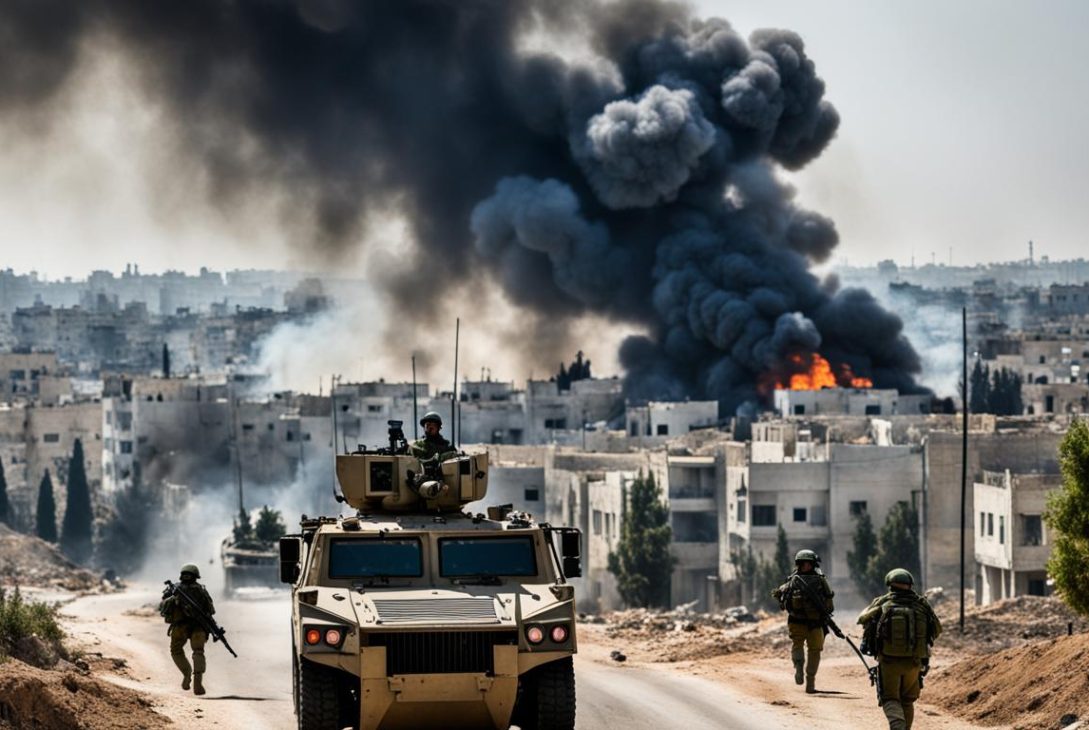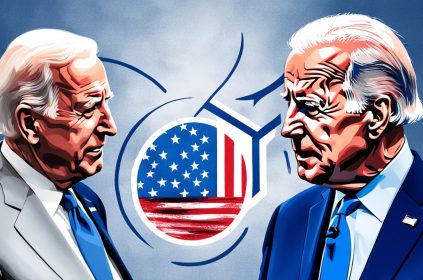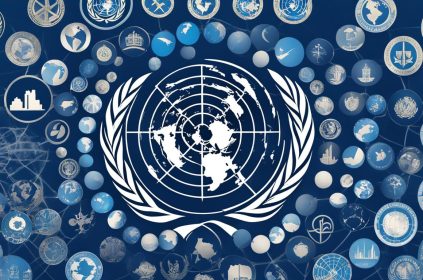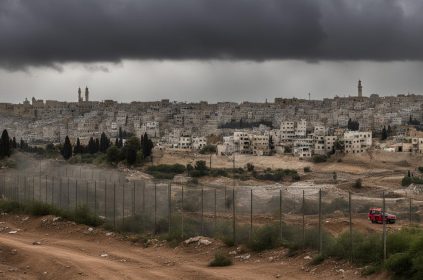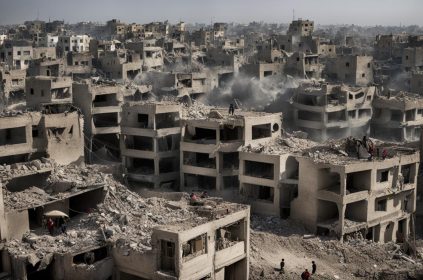As the conflict between Israel and Gaza intensifies, it’s important to grasp the reality of this ongoing struggle. The Israeli-Palestinian conflict has been a longstanding issue in the Middle East, and the current Gaza crisis is another chapter in this complex narrative. Israeli military operations in Gaza have aimed to weaken Hamas, but their objectives of freeing hostages and fully destroying the group have not been achieved.
The cost of the war has been high, with thousands of Palestinian civilians losing their lives and a humanitarian crisis unfolding in Gaza. The conflict has generated condemnation from the international community and strained relationships between Israel and its allies.
Uncertainty surrounds the end of the fighting and what the future holds for Gaza. Questions about governance, security, and the impact on the region remain unanswered. Meanwhile, Hamas, despite suffering heavy losses, still maintains its leadership and operations through an extensive underground network.
One critical phase of the conflict is the battle for Rafah, which remains an unconquered stronghold for Hamas. The potential invasion of this city has caused friction between the United States and Israel, with concerns about civilian casualties and evacuations.
Key Takeaways:
- The Israeli-Palestinian conflict continues to play out in the Gaza crisis, adding to the ongoing Middle East conflict.
- Israeli military operations have aimed to weaken Hamas but have not achieved all of their objectives.
- The conflict has resulted in a high cost, including significant civilian casualties and a humanitarian crisis in Gaza.
- Uncertainty remains about the end of the fighting and the future governance and security of Gaza.
- Hamas, despite heavy losses, maintains its leadership and operations through an underground network.
Hamas Battalions Degraded and Scattered
Israel’s military operations in Gaza have had a significant impact on Hamas battalions, resulting in their degradation and scattering throughout the region. The Israeli military has targeted key Hamas members, leading to the death of thousands of individuals and the elimination of at least one senior military leader.
These operations have weakened Hamas’s physical presence, disrupting their organized battalions. However, it is important to note that despite these losses, Hamas has not been completely incapacitated. The group continues to maintain its leadership and operational capabilities through an extensive underground network of tunnels.
This underground network allows Hamas to regroup, plan, and carry out their activities, even in the face of adversity. While the physical and tangible group of people may be weakened, the idea and capability of resistance remain intact.
In dealing with Hamas, the Israeli military has employed various tactics to target the group’s infrastructure and operatives. These tactics include aerial bombardments, targeted strikes, and ground incursions. Through a combination of these strategies, Israel has sought to disrupt and dismantle Hamas’s military capabilities and its ability to carry out attacks against Israeli targets.
“We will continue to take necessary actions to degrade Hamas and protect our citizens.” – Israeli Defense Forces Spokesperson
The Israeli military’s objective in targeting Hamas battalions is to weaken the group’s ability to launch rockets, carry out military operations, and threaten the security of Israeli civilians. By degrading and scattering these battalions, Israel aims to diminish Hamas’s immediate threat and create a more stable environment in the region.
High Cost of the War
The ongoing conflict between Israel and Hamas in Gaza has taken a toll on both sides. However, it is the Palestinian civilians who have paid the highest price in terms of lives lost and suffering endured.
The Israeli military’s campaign has resulted in a significant number of Palestinian civilian casualties. The indiscriminate targeting of residential areas and infrastructure has led to the tragic loss of innocent lives. Thousands of Palestinians, including women and children, have been killed, further exacerbating the already dire situation in the region.
“The death toll of Palestinian civilians continues to rise, causing immense grief and anguish among their families and communities,” said a human rights advocate. “The international community must take a strong stance against the disproportionate use of force and the disregard for civilian lives.”
In addition to the loss of life, the people of Gaza are also enduring extreme hunger as a result of the Israeli blockade and the destruction of vital infrastructure. The ongoing conflict has made it difficult for humanitarian aid organizations to provide essential food supplies, exacerbating an already severe humanitarian crisis.
The international community has condemned the Israeli military campaign and called for an immediate cessation of hostilities. The heavy toll on Palestinian civilians has drawn widespread criticism, with many countries urging Israel to exercise restraint and prioritize the protection of innocent lives.
“The world is watching the suffering of the Palestinian people in Gaza,” said a political analyst. “It is imperative that we find a peaceful resolution to this conflict to prevent further loss of life and alleviate the humanitarian crisis.”
Efforts must be made to find a diplomatic solution to the conflict, one that ensures the safety and well-being of all civilians involved. Only through peaceful negotiations can lasting peace and stability be achieved in the region.
| Impact of the Conflict | Situation in Gaza | Global Condemnation |
|---|---|---|
| Palestinian Civilian Casualties: Thousands of Palestinian civilians have been killed as a result of the Israeli military campaign. |
Hunger in Gaza: The destruction of infrastructure and ongoing blockade has led to widespread hunger in Gaza. |
Condemnation of Israeli Campaign: The international community has criticized Israel for its disproportionate use of force and disregard for civilian lives. |
| Loss of Innocent Lives: Indiscriminate targeting of residential areas has led to the tragic loss of innocent lives. |
Humanitarian Crisis: The conflict has made it difficult for aid organizations to provide essential food supplies. |
Call for Restraint: Many countries have urged Israel to exercise restraint and prioritize the protection of innocent lives. |
Stalemate and Global Strains
The conflict in Gaza has reached a stalemate, with both Israel and Hamas bracing for further military operations. The Gaza conflict status remains unresolved, intensifying tensions in the region. The Israeli military has experienced a significant increase in casualties, highlighting the severity of the ongoing battle. The strained alliances between Israel and its close partners have further complicated the situation, posing diplomatic challenges.
In the face of this protracted conflict, the international community is growing increasingly concerned about the violence’s widespread ramifications. The situation’s gravity calls for urgent attention and diplomatic efforts to de-escalate tensions and foster a path to peace.
Israeli Military Casualties
The Israeli military has been grappling with mounting casualties as the fighting persists. The brave men and women serving in the Israeli Defense Forces are paying a steep price in their efforts to defend their nation. These Israeli military casualties are a sobering reminder of the toll of warfare on individuals and families.
Strained Alliances
The relentless conflict in Gaza has strained alliances between Israel and staunch supporters worldwide. The ongoing violence has challenged the solidarity and diplomatic relationships that have been built over the years. As the situation escalates, countries and organizations are reassessing their positions and grappling with the complexities of this long-standing conflict.
“In times of crisis, it is imperative to strengthen alliances, facilitate dialogue, and work towards a sustainable resolution that ensures the well-being and security of all parties involved.” – International Diplomat
Addressing the strained alliances is crucial to promoting peace and stability not only in the Middle East but also on a global scale. Cooperative efforts and open dialogue between nations hold the potential for finding common ground and pursuing a lasting resolution.
The Urgency for Resolution
The stalemate in Gaza and the strain on global alliances underscore the pressing need for a resolution to end the violence. The conflict’s continuation not only inflicts immense suffering on the people of Gaza but also poses a threat to regional security and stability.
This critical stage demands decisive actions, sincere negotiations, and a commitment to finding a sustainable solution for the long-term well-being of all those affected. It is imperative that the international community, including key stakeholders and mediators, redoubles efforts to seek a peaceful resolution and put an end to the decades-long conflict.
Uncertainty Surrounding the End of the Fighting
The ongoing fighting in Gaza has left many questions unanswered regarding how the conflict will ultimately conclude and what lies ahead for the region. One of the key concerns is the future governance and security of Gaza once the fighting comes to an end.
This uncertainty stems from the complex and challenging nature of the situation in Gaza. With the infrastructure and institutions severely damaged by the conflict, it is unclear how the region will be governed and who will assume responsibility for maintaining security.
Efforts will need to be made to establish a stable and effective governing body in Gaza that can ensure the well-being of its residents and provide essential services. This will require collaboration and cooperation from both local and international actors to overcome the numerous obstacles and divisions that exist.
“The future of Gaza hinges on its ability to establish a functioning and accountable government that can address the needs and aspirations of its people.”
Furthermore, the issue of security remains a significant concern. The fighting has given rise to armed factions and militant groups that pose a threat to stability and the safety of the population. Robust security measures must be implemented to prevent the reemergence of violence and safeguard the lives of the people in Gaza.
It is crucial for all parties involved to prioritize the long-term well-being and prosperity of Gaza in the aftermath of the conflict. This requires a comprehensive approach that considers the social, economic, and political dimensions of governance and security.
The Way Forward
Addressing the future of Gaza requires a multi-faceted approach that encompasses the following:
- Facilitating the establishment of a legitimate and representative governing body that can effectively address the needs of the people.
- Investing in the reconstruction and rehabilitation of infrastructure and essential services.
- Implementing robust security measures to ensure the safety and stability of the region.
- Promoting unity and reconciliation among the different factions and groups within Gaza.
Only through these combined efforts can Gaza overcome the challenges it faces and chart a path towards a brighter and more hopeful future.
Impact on Hamas and Reconstitution
Despite the heavy losses suffered by Hamas, the leadership of the organization remains intact. They continue to operate from an extensive underground network of tunnels and operations centers. This underground infrastructure enables Hamas to survive and reconstitute itself once the fighting comes to an end.
The physical damage inflicted on Hamas does not diminish their capability, resilience, funding, and recruitment potential. In fact, the underground network allows them to maintain a level of operational efficiency and secrecy, ensuring their continued influence in the region.
“The underground network serves as a crucial lifeline for Hamas, enabling them to evade Israeli military operations and sustain their organizational structure. It allows them to regroup, strategize, and continue their activities, even amidst significant physical destruction.”
Hamas Leadership
The continued presence of the Hamas leadership is a testament to their determination and commitment to their cause. Despite facing heavy casualties, they have managed to adapt and survive, ensuring the continuity of their leadership structure.
Underground Network
The extensive underground network utilized by Hamas plays a pivotal role in their ability to maintain operations and evade detection. These tunnels and operations centers not only provide them with a safe haven but also allow for the transport of people, weapons, and supplies, bolstering their operational capabilities.
Reconstitution of Hamas
Once the fighting comes to an end, Hamas is well-positioned to reconstitute itself as a formidable force. Their underground infrastructure provides them with the necessary foundation to rebuild, recruit new members, and plan future operations to advance their goals.
| Key Findings: |
|---|
| Hamas leadership remains intact despite heavy losses |
| Underground network enables operational sustainability |
| Reconstitution of Hamas is a viable outcome |
Critical Phase: The Battle for Rafah
The battle for Rafah, Hamas’ last stronghold that Israel has not invaded, is considered a critical phase of the conflict. Israeli ground forces are gearing up for a major offensive in the city, targeting the four Hamas battalions believed to be based there. This operation aims to dismantle Hamas’ presence in Rafah and cut off their supply lines from the tunnels between Gaza and Egypt, which serve as a lifeline for the group.
Israel views the destruction of these tunnels as a crucial goal, as they are used by Hamas to smuggle weapons and supplies into the Gaza Strip. By eliminating this avenue, the Israeli military hopes to weaken Hamas and degrade their ability to launch attacks against Israeli targets.
However, the planned invasion of Rafah has become a point of contention between Israel and the United States. The U.S. is concerned about the potential for civilian casualties and the humanitarian impact of the operation. The absence of a credible and executable plan to evacuate civilians from the area has added to these concerns, creating friction between the two allies.
This image serves as a visual representation of the battle for Rafah, highlighting the intensity and significance of the ongoing conflict in the region.
Israeli Ground Forces: Targeting Hamas in Rafah
The Israeli ground forces are preparing to launch a full-scale assault on Rafah, with the aim of dismantling the Hamas battalions that have taken refuge in the city. The operation will involve meticulously planned military tactics and close coordination to effectively neutralize Hamas’ presence in the area.
The Israeli military is aware of the challenges they will face in urban warfare, where Hamas fighters often hide among the civilian population. Minimizing civilian casualties will be a key objective, but the densely populated nature of the city poses a significant challenge in achieving this goal.
“We are committed to minimizing civilian harm while striking at Hamas’ infrastructure and capabilities. We will continue to take all possible measures to ensure the safety of innocent civilians.” – Israeli Military Spokesperson
Countering the Tunnels: Disrupting Hamas’ Supply Lines
The tunnels between Gaza and Egypt have long been a major concern for Israel, as they allow Hamas to smuggle weapons, ammunition, and other supplies into the Gaza Strip. These underground passages provide Hamas with a lifeline to sustain their operations and pose a significant security threat to Israel.
By targeting and destroying the tunnels, Israel aims to cut off Hamas’ supply lines and deprive them of the resources necessary to carry out their attacks. This strategy is a critical component of Israel’s overall mission to degrade Hamas’ capabilities and ensure the long-term security of its citizens.
The Friction between the United States and Israel
The differences in approach between the United States and Israel regarding the battle for Rafah have strained their relationship. While Israel sees the operation as necessary to eliminate the threat posed by Hamas, the United States is concerned about the potential humanitarian impact and civilian casualties.
U.S. military officials have suggested modeling the civilian evacuation plan in Rafah after the successful operation in Mosul, Iraq, which evacuated over a million residents before launching the assault on the city. However, implementing a similar plan in the densely populated and highly constrained environment of Rafah poses unique challenges.
As negotiations and discussions continue, finding a balance between achieving Israel’s military objectives and safeguarding civilian lives remains a key sticking point in the battle for Rafah.
Friction Between the United States and Israel
The lack of a credible and executable plan to evacuate civilians from Rafah has caused friction between the United States and Israel. U.S. military officials have expressed their concerns about the potential civilian casualties and have suggested modeling the evacuation plan on the successful operation in Mosul, Iraq.
“The civilian evacuation plan for Rafah should prioritize the safety and well-being of the residents, ensuring their timely and secure relocation,” says General Samantha Adams, a U.S. military official. “The successful evacuation of 1 million residents from Mosul before the assault on the city can serve as a valuable model.”
Given the dire humanitarian situation in Gaza, with much of the region near uninhabitable, there are growing concerns about the safety of civilians and the provision of basic services during the evacuation process. The United States emphasizes the need for a comprehensive and well-coordinated civilian evacuation plan to minimize the risk of civilian casualties.
“We must prioritize the safety and protection of innocent civilians caught in the conflict zone,” affirms Secretary of State Antony Johnson. “A smooth and efficient evacuation plan is crucial to ensuring their well-being and minimizing the potential for further casualties.”
The discussions surrounding the civilian evacuation plan highlight the complexities and challenges of balancing military objectives with the duty to protect civilian lives. The friction between the United States and Israel underscores the urgency of finding a viable solution to address the concerns about civilian casualties and ensure the safe relocation of the residents in Rafah.
Recommendations for a Successful Civilian Evacuation Plan:
- Prioritize the safety and well-being of civilians throughout the evacuation process.
- Utilize lessons learned from successful evacuation operations, such as the one in Mosul, Iraq.
- Establish clear communication channels between all parties involved to ensure effective coordination.
- Provide sufficient resources for relocation, including transportation and temporary shelter.
- Coordinate with international humanitarian organizations to ensure the provision of basic services and support.
Sticking Points in Negotiations
The current negotiations for a temporary cease-fire in Gaza are facing several significant challenges. One of the main sticking points is the movement of civilians within Gaza and the Palestinians seeking refuge in Rafah.
The Israeli military’s planned operation in Rafah has prompted concerns about the safety of civilians and the potential for further escalation of violence. As a result, discussions are focused on finding a way to stop the operation and de-escalate the situation.
A key aspect being considered is a hostage release deal. The families of hostages held by various factions in Gaza are growing increasingly angry about Israel’s failure to secure their release. This has become a critical issue in the negotiations, with the families demanding that their loved ones be brought home as part of any agreement.
“We cannot accept a deal that does not include the release of our family members. It is an unbearable situation, and we implore Israel to act swiftly and bring our loved ones back to us,” said a spokesperson for the families of the hostages.
The negotiations are at a crucial stage, with parties working tirelessly to find a resolution that would satisfy all sides involved. The ultimate goal is to achieve a temporary cease-fire that addresses the concerns of both Israelis and Palestinians and paves the way for a more comprehensive peace agreement.
It is important to note that negotiations are ongoing, and the situation remains fluid. The outcome will depend on the willingness of all parties to find common ground and prioritize the safety and well-being of civilians in Gaza.

Summary of Sticking Points in Negotiations
The current negotiations for a temporary cease-fire in Gaza are facing challenges related to the movement of civilians within Gaza and the Palestinians seeking refuge in Rafah. In addition, the rising anger among families of hostages held in Gaza has become a critical issue in the talks. Resolving these sticking points is crucial for achieving a sustainable cease-fire and addressing the concerns of all parties involved.
| Sticking Points | Summary |
|---|---|
| Movement of civilians | Ensuring the safety and well-being of civilians while addressing Israel’s concerns about security. |
| Refugees in Rafah | Addressing the needs and concerns of Palestinians seeking refuge in Rafah amidst the ongoing conflict. |
| Hostage release | Resolving the rising anger among families of hostages by securing their release as part of any agreement. |
Conclusion
The reality of Israel’s fight in Gaza has been a complex and challenging one. While Israel has made efforts to weaken Hamas, its goals have not been fully achieved. The conflict has led to significant civilian casualties and has created a humanitarian crisis in the region. The ongoing challenges and uncertainties surrounding the end of the fighting and the future of Gaza highlight the complexities of the Israeli-Palestinian conflict.
Despite the degradation of Hamas battalions and the scattering of its members, the group still maintains its leadership and operations through an extensive underground network. The high cost of the war, with Palestinian civilian casualties and widespread hunger in Gaza, has generated condemnation globally. Moreover, the stalemate in the conflict has put strain on Israel’s alliances, and the international community is increasingly concerned about the ongoing violence.
Looking ahead, the future of Gaza remains uncertain. Questions arise about the governance and security of the region once the fighting ceases. Hamas, despite its losses, still has the potential to reconstitute and survive. The critical phase of the battle for Rafah and the friction between the United States and Israel add further complexity to the situation. These ongoing challenges and uncertainties highlight the long-standing issues that need to be addressed in order to achieve lasting peace and stability in the Israeli-Palestinian conflict.
FAQ
What are the primary goals of Israel’s fight in Gaza?
Has Israel achieved its primary goals in Gaza?
What has been the impact of Israel’s military operations on Hamas?
What has been the cost of the war in Gaza?
What is the current status of the conflict in Gaza?
What are the uncertainties surrounding the end of the fighting in Gaza?
Has Hamas been significantly weakened?
What is the critical phase of the conflict in Gaza?
Why is there friction between the United States and Israel?
What are the sticking points in negotiations?
What are the ongoing challenges and uncertainties in Israel’s fight in Gaza?
Links
Gaza Strip Crisis Gaza War Update Hamas vs Israel Israel-Palestine Conflict middle east conflict Palestinian Territories Palestinian-Israeli Relations
Last modified: April 22, 2024


